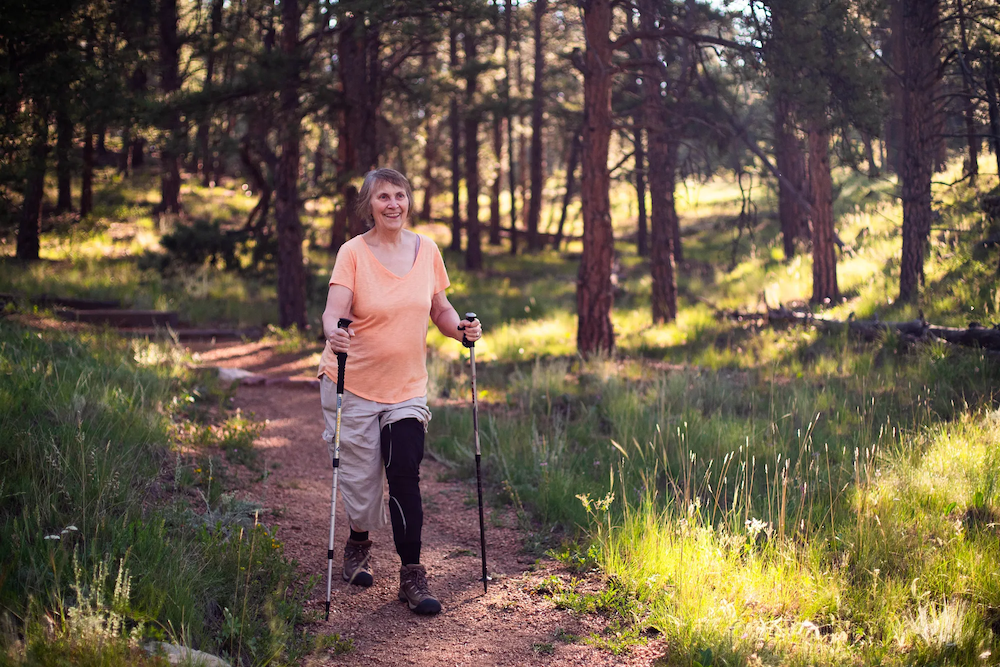
According to the NIH, approximately 14% of people in the U.S. live with a mobility impairment and have serious difficulty walking or climbing stairs. Limited mobility can be caused by anything from aging or injuries to neurologic or muscular disorders. If you’re struggling with walking, walking aids can be used to improve your gait, balance, safety, and overall sense of independence.
Types of walking aids
Choosing the right walking aid requires careful consideration. From traditional options like canes, walkers, and crutches, to more advanced solutions such as bionic clothing, here’s an in-depth look into the world of walking aids.
Canes
Canes are among the most commonly used walking aids and come in various styles and designs. They provide stability and support by redistributing weight from the legs to the upper body. When used correctly, canes can unload the leg opposite of the cane by up to 25%. Canes are typically used by people with only minor balance and mobility challenges.
Canes are useful for:
- Improving balance while walking
- Relieving pressure on joints in the leg and foot to decrease pain
- Reducing the risk of falling
- Compensating for leg weakness on one side of the body
Types of canes
There are several types of canes, including single-point canes, quad canes, and folding canes with seats. Single-point canes offer basic support and balance assistance, while quad canes feature a wider base for increased stability. while seated canes have seats that can be unfolded whenever and wherever the user needs to take a break from walking and sit down.
Types of cane handles
When choosing a cane, there are a variety of handle types to consider. Common handle types include:
- Round — Round handles are the most traditional option and can give the user lots of space to find the most comfortable position. They can easily be hooked over the arm, which can be convenient when opening doors, but can be uncomfortable due to pressure through the wrist when used for an extended period of time. Rounded handle canes are sometimes called crook canes.
- Derby — Derby handles are a thicker, curved alternative that offers more comfort than a standard round handle. Derby canes are easy to grip and ideal for people suffering from arthritis or hand weakness but generally popular among all cane users.
- Offset — Offset canes have a bend in the shaft that’s designed to position the handle over the length of the shaft in order to evenly distribute the user’s weight along it. They’re shaped like a question mark, which helps reduce strain on the wrist. Typically, offset handles are padded to provide a more comfortable grip.
Crutches
Crutches are another popular walking aid, particularly for individuals recovering from leg injuries or surgeries. They offer more support than canes but are often for temporary use. Traditional crutches, also known as axillary crutches, require the user to support their weight using their arms, while forearm crutches, also known as Lofstrand or Canadian crutches, provide additional forearm support.
Both types can be adjusted to suit the user’s height and comfort level. Proper technique and fitting are crucial when using crutches to ensure safety and minimize strain on the body.
Crutches are useful for:
- Temporary injuries that require reduced weight bearing of one foot, ankle, or knee
- Longer-term conditions that result in leg weakness or spasticity
- Increased stability
Typically, crutches are not recommended for people who have impaired balance, due to the strength and coordination required to utilize them.
Types of crutches:
There are two types of crutches, which include:
- Axillary crutches, the most common type of crutch, that rests under your armpits. Axillary crutches require training to use and can create hand and wrist pain with long-term use.
- Forearm crutches are often more comfortable than axillary crutches, but require much more upper-body strength and coordination to use. They are more suitable for long-term use.
Walkers
Walkers offer sturdy support and stability for individuals who require assistance while walking. These aids typically consist of a metal frame with four legs and hand grips for the user to hold onto.
Walkers are useful for:
- Improving balance due to leg weakness
- Providing stability when sensation in the legs is impaired
- Reducing weight through the joints in the legs to decrease pain
- Reducing the risk of falls
When used correctly, walkers can support up to 50% of the user’s body weight; however, the user must have sufficient upper body strength and hand grip strength to do so.
Types of walkers
Walkers come in different configurations, including standard pick-up walkers, 2-wheeled walkers, 4-wheeled walkers or rollators, and hemi walkers. Standard pickup walkers provide maximum stability but require lifting and moving the entire frame.
Two-wheeled walkers have two wheels on the front legs, making them easier to maneuver.
Four-wheeled walkers or rollators feature four wheels and often include a seat, and handbrakes, offering a convenient solution for those needing rest breaks during walks.
Hemi walkers are one-arm walkers and are often used by individuals who have limited use of one arm.
Bionic Clothing

Advancements in technology have made it possible to develop innovative walking aids like bionic clothing. Bionic clothing uses continuous motion analysis and functional electrical stimulation to monitor and activate the necessary muscles throughout the gait cycle to improve walking. While traditional devices like walkers, canes, or crutches provide important support, they fail to address the underlying neuromuscular system of individuals impacted by neurological conditions.
Bionic clothing offers a more complete integration with the neuromuscular system. The complexity of neurologic conditions requires solutions that can continuously measure the efficacy of intervention and optimize to individual context. This is why bionic clothing can be such a powerful mobility solution.
Bionic clothing is useful for:
- Increasing strength
- Improving range of motion
- Facilitating muscle re-education
- Improving the efficiency of walking
- Assisting in normalizing walking patterns
Types of bionic clothing:
The Cionic Neural Sleeve is the first and only bionic clothing for mobility impairment. It is FDA-cleared as a Class II medical device and is indicated to help individuals with limited mobility and lower leg weakness due to multiple sclerosis, cerebral palsy, stroke, and other upper motor neuron disorders. It stimulates all four major muscle groups of the leg, sequenced to an individual’s gait pattern.
In the first multi-site research trial with the Neural Sleeve to examine how the Neural Sleeve performed for individuals who experience foot drop, 94% of participants experienced increased ankle dorsiflexion at heel strike.
Factors to consider when comparing walking aids
To determine which walking aid is right for you, there are a number of external factors to consider.
Mobility requirements:
Assess your individual mobility needs. Determine whether you require minimal support, such as a cane, or a more substantial aid like a walker. Bionic clothing can often be used with other walking aids. Consider factors such as desired walking speed, endurance, balance, type of terrain you’ll be walking on, and current and desired activity levels when choosing a walking aid.
Weight and portability:
Consider the weight and portability of different walking aids. If you need to transport it frequently or have limited strength, opt for lightweight models that are easy to fold or disassemble for storage and travel such as bionic clothing or canes if appropriate for your particular mobility needs.
Height adjustability:
If you’re opting for a cane, walker, or crutches, ensure it can be adjusted to a comfortable height that suits your posture and gait pattern. Proper height alignment helps maintain proper body mechanics and reduces strain on your back, shoulders, and wrists.
Grip and handle comfort:
Pay attention to the grip and handle design. Look for ergonomic handles that provide a secure and comfortable grip, minimizing strain on your hands and wrists. Foam or cushioned handles can be particularly beneficial for those with hand pain or weakness.
Maneuverability:
Consider the maneuverability of the walking aid. Can it navigate tight spaces, doorways, and corners easily? Swivel wheels or front-wheel rotation can enhance maneuverability, especially in crowded or confined areas. Bionic clothing can be used anywhere as it is a wearable garment.
Aesthetic preferences:
While not the primary consideration, the aesthetic appeal of the walking aid can play a role in your selection. Choose a design and color that you feel comfortable and confident using. Bionic clothing, for example, is more discreet than a walker or cane and looks more like an athletic legging than a mobility device.
Professional guidance:
Always consult with a physical therapist or other qualified healthcare professional to guide you in choosing the most suitable walking aid for your specific condition. They can provide expert advice, assess your individual mobility needs, and ensure proper fit and usage.
Selecting the right walking aid is crucial for your safety, comfort, and independence. Take the time to evaluate your needs, consider the features that matter most to you, and seek professional guidance from a healthcare provider when needed.
With the right walking aid, you can regain confidence, improve mobility, and enjoy a more active, independent lifestyle.





